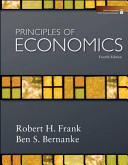
1 säljare
Principles of Economics Upplaga 4
In recent years, innovative texts in mathematics, science, foreign languages, and other fields have achieved dramatic pedagogical gains by abandoning the traditional encyclopedic approach in favor of attempting to teach a short list of core principles in depth. Two well-respected writers and researchers, Bob Frank and Ben Bernanke, have shown that the less-is-more approach affords similar gains in introductory economics. Although a few other texts have paid lip service to this new approach, Frank/Bernanke is by far the best throughout, and the best executed principles text in this mold. Avoiding excessive reliance on formal mathematical derivations, it presents concepts intuitively through examples drawn from familiar contexts. The authors introduce a coherent short list of core principles and reinforce them by illustrating and applying each in numerous contexts. Students are periodically asked to apply these principles and to answer related questions and exercises.Frank/Bernanke also encourages students to become "Economic Naturalists," by employing basic economic principles to understand and explain what they observe in the world around them. An economic naturalist understands, for example, that infant safety seats are required in cars but not in airplanes because the marginal cost of space to accommodate these seats is typically zero in cars but often hundreds of dollars in airplanes. Such examples engage student interest while teaching them to see each feature of their economic landscape as the reflection of an implicit or explicit cost-benefit calculation.
Upplaga: 4e upplagan
Utgiven: 2009
ISBN: 9780073402888
Förlag: McGraw-Hill Education
Format: Inbunden
Språk: Engelska
Sidor: 928 st
In recent years, innovative texts in mathematics, science, foreign languages, and other fields have achieved dramatic pedagogical gains by abandoning the traditional encyclopedic approach in favor of attempting to teach a short list of core principles in depth. Two well-respected writers and researchers, Bob Frank and Ben Bernanke, have shown that the less-is-more approach affords similar gains in introductory economics. Although a few other texts have paid lip service to this new approach, Frank/Bernanke is by far the best throughout, and the best executed principles text in this mold. Avoiding excessive reliance on formal mathematical derivations, it presents concepts intuitively through examples drawn from familiar contexts. The authors introduce a coherent short list of core principles and reinforce them by illustrating and applying each in numerous contexts. Students are periodically asked to apply these principles and to answer related questions and exercises.Frank/Bernanke also encourages students to become "Economic Naturalists," by employing basic economic principles to understand and explain what they observe in the world around them. An economic naturalist understands, for example, that infant safety seats are required in cars but not in airplanes because the marginal cost of space to accommodate these seats is typically zero in cars but often hundreds of dollars in airplanes. Such examples engage student interest while teaching them to see each feature of their economic landscape as the reflection of an implicit or explicit cost-benefit calculation.
Begagnad bok
299 kr
Fri frakt & skickas inom 1-3 vardagar
Köpskydd med Studentapan
Varje köp täcks av Studentapans köpskydd som säkerställer att boken kommer fram, att du får rätt bok och att skicket stämmer överens med beskrivning.



